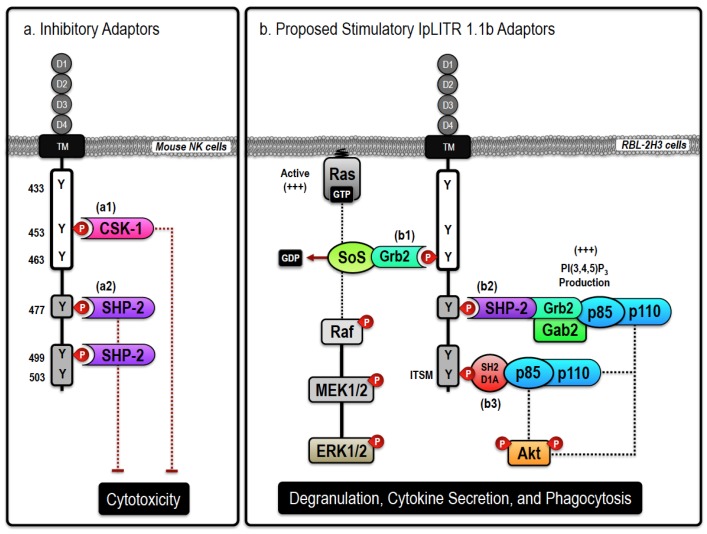Figure 1.
Proposed inhibitory and stimulatory (Ictalurus punctatus) leukocyte immune-type receptors (IpLITR) 1.1b-mediated intracellular signaling events. Schematic representation of the proposed inhibitory (a) and stimulatory (b) signaling events mediated by IpLITR 1.1b in transfected cells. The cytoplasmic tail (CYT) region of IpLITR 1.1b contains six tyrosine residues (Y433, Y453, Y463, Y477, Y499, and Y503) that, when phosphorylated, serve as potential docking sites for various intracellular signaling adaptors. (a) In mouse natural killer (NK) cells, we demonstrated that engagement of IpLITR 1.1b caused a potent inhibition of NK cell-mediated cytotoxicity due to the recruitment of Csk-1 at Y453 (a1) or the binding of SH2 domain-containing cytoplasmic phosphatases (SHP) at Y477 and/or Y499, which are in immunoreceptor tyrosine-based inhibition motifs (ITIMs) (a2) [64,65]. The immunoreceptor tyrosine-based switch motifs (ITSM) located at Y503 may also recruit SHP phosphatases but this has not been examined. (b) IpLITR 1.1b engagement also induced phosphorylation of ERK1/2 and Akt as well as promoted phagocytosis in transfected rat basophilic leukemia (RBL)-2H3 cells [46]. These stimulatory effector cell functions could be mediated by the following mechanisms; (b1) direct recruitment of growth factor receptor-bound 2 (Grb2) to the YxN motif at Y463 may mediate the recruitment, and associated GEF activity, of SoS or the Gab2/class I PI3K (p85/p110) signaling complex. SoS is known to stimulate the accumulation of GTP-loaded Ras that would facilitate the stepwise phosphorylation of the Raf-MEK-ERK cassette. Alternatively, the Gab2 adaptor can localize class I PI3K activation to allow for targeted accumulation of the important signal transduction molecule phosphatidylinositol 3,4,5-trisphosphate (PI(3,4,5)P3); (b2) ITIM-mediated recruitment of SHP-2 at Y477 or Y499, could recruit Grb2 and Gab2 allowing for the association of holomeric class I PI3Ks (p85/p110) leading to Akt phosphorylation and induction of phagocytosis. SHP-2-dependent recruitment of class I PI3Ks could also occur at the C-terminal ITSM located at Y503. SHP-2-dependent Grb2 recruitment may also trigger the SoS/Ras/Raf/MEK-dependent activation of ERK1/2; (b3) SH2D1A-mediated binding of PI3K (p85/p110) to the ITSM at Y503 is also possible. In general, class I PI3K activation can result in Akt phosphorylation or the recruitment of other PI(3,4,5)P3-dependent signaling proteins, including Vav, that are known to regulate phagocytosis. In addition, ITSM-mediated signaling can also recruit the adaptor EAT-2, closely related to SH2D1A, which is not shown here. For clarity, the role of signaling events dependent upon extracellular Ca2+ entry or intracellular Ca2+ mobilization have also been excluded.

